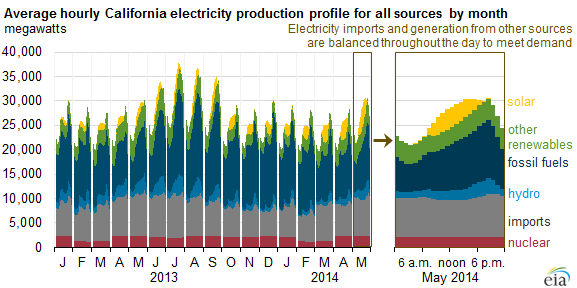Big solar shines in America's biggest state
On June 1, 2014, the California Independent System Operator (CAISO) recorded a record midday hourly peak of 4767 megawatts of alternating current (MWAC) of utility-generated solar electricity delivered into the California grid. With rapidly growing utility-scale solar capacity, CAISO has regularly recorded new hourly output records going back to 2010 when it first began publishing the daily data. When the hourly data are averaged over the course of a month to control for weather variation, the average peak hourly generation in May 2014 of 4086 MWAC was 150 per cent greater than the level in May 2013.
In 2013, 2145 MW of utility-scale solar capacity entered service in California, of which more than 500 MW came from large-scale solar thermal plants. California accounted for more than 75 per cent of US utility-scale solar capacity installed in 2013.
Total solar electricity output in May 2014 constituted 6 per cent of the total CAISO electricity load that month, compared with 2 per cent in May 2013. However, during the average peak solar output hour, between 11:00am and noon for May 2014, solar supplied 14 per cent of total power, compared with 6 per cent in May 2013.
Solar generation facilities generally provide power to the CAISO grid from early morning until the evening, and reach peak output around midday. When solar electricity is being generated, less electricity from other sources such as natural gas or interstate electricity imports is required. Conversely, when there is little-to-no solar generation, the shares of other fuels used in California's supply mix rise.
Source: CAISO Daily Renewables Watch (Note: Data do not include distributed generation solar electricity where output is behind-the-meter.)
While solar generation follows a relatively consistent pattern throughout the day (see graph 2), CAISO also faces challenges in integrating other renewables (see graph 3). Wind output during the summer months frequently coincides with the afternoon and evening peak demand hours, but it is also an intermittent resource and therefore has a limited ability to provide firm capacity. Hydroelectric power, which provides 12 per cent of California's net generation, is typically a flexible, dispatchable resource—but is also subject to seasonal variability, drought effects, and restrictions on dispatch created by the needs of other water users.
Solar and renewables still constitute a relatively small share of generation for California in the context of all fuel sources (graph 4). Natural gas accounted for 59 per cent of net generation in 2013, and 3940 MW of new natural gas capacity came online in 2013, which will help address some of the reserve capacity needs for balancing renewables, as well as replace some of the baseload power that was lost when two of the state's four nuclear units were retired in 2012.



(Note: Thes charts show a set of 24 hours for each month, calculated from CAISO's average hourly output data by taking the average output for each hour in a given month. The peaks therefore do not exactly correspond to actual peak outputs, but should approximate the average peak hourly output in a given month.)
California's utilities are less than two-thirds of the way toward meeting their 2020 RPS goals. With declining solar manufacturing costs, and the federal investment tax credit in place through the end of 2016, utility-scale solar installations are expected to continue through 2014. Projects currently reporting to EIA have indicated plans for an additional 1728 MWAC of new utility-scale solar to be installed between May and December 2014.
In addition to leading the nation in utility-scale solar capacity, California also has a significant level of behind-the-meter residential and commercial solar photovoltaic capacity. According to the Solar Energy Industries Association, approximately 700 MWDC of residential and commercial/industrial solar PV capacity was also installed in California in 2013, further reducing midday baseload power demand.
Originally published by the US Energy Information Administration. Reproduced with permission.

















